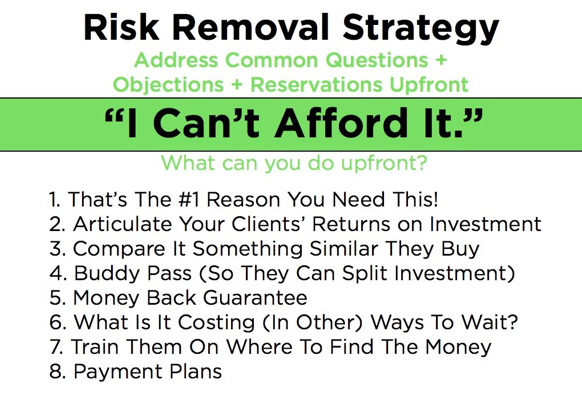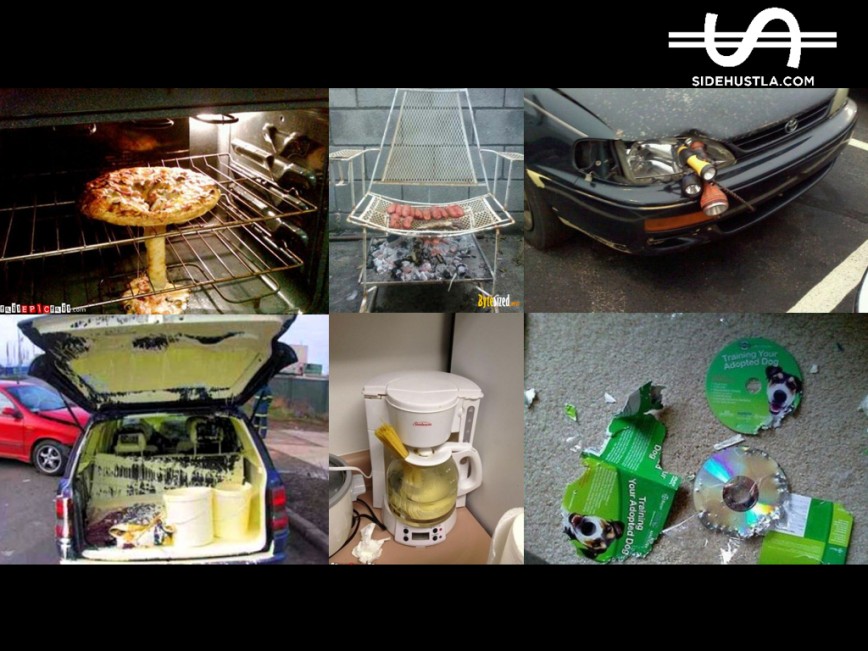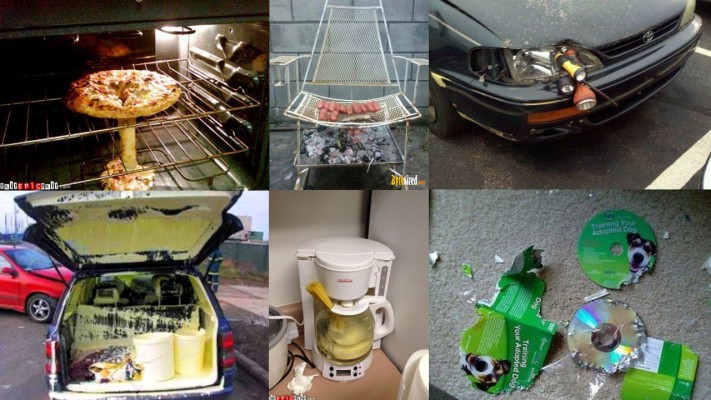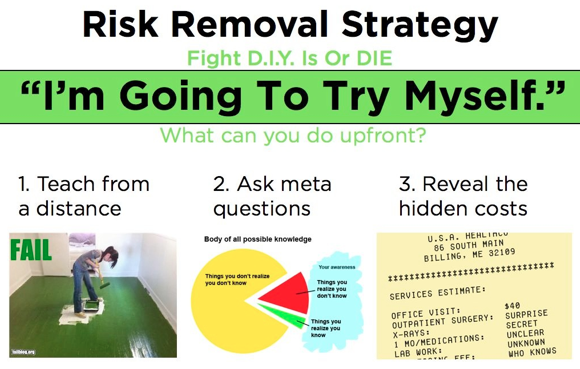Most side hustlas think that their worst enemy when selling is the competition. But here is the thing. You only have competition if who you’re selling to knows about someone else who does what you do. Usually, they don’t and even if they do, you win in the trust category because they know you already. If you are the only person they know that does what you do, your only competition is them thinking they can do it on their own.
Therefore, your worst enemy when selling your products or services is likely D.I.Y. or Do It Yourself. Your greatest competitor is the potential customer trying to do what you do on their own. You have to help them get to Y.D.I. or You Do It if you want your business to grow.
Since elementary school, we were taught that we should know all of the answers ourselves. Asking for help from another person meant we were dumb, weak, or even cheating. So even when we had a difficult class—for me it was science—we refrained from getting tutoring, staying before or after school to go to office hours, or asking a friend to teach us. While this satisfies the potential customer’s desire to keep learning, them thinking they know it all or that they can do what you do as good as you in a few days or so stops them from learning from you.
What DIYers thinks vs. What YDIers think
Today, your potential customers still carry that feeling and desire to be independent. They may say things like:
“No thanks. I got it.”
“I’ve done that before.”
“I can do it on my own.”
“I’m going to give it a try first.”
“I’ll just look it up on the internet.”
“I want to learn how to do that.”
“I’m great at doing that.”
Your second job as the lead salesperson for your product or service is to get them to say things like this instead:
“Wow. I didn’t even think about that.”
“How did you do that so fast?”
“I can’t do that nearly as well as you.”
“How do you know all of this?”
“I don’t have the time to do what you do.”
If you can’t get them to immediately see the difference between your ability to get them from some sort of Point A to their desire Point B, then DIY will cause your company to say bye bye. And it won’t be your potential customers’ fault for not understanding you and what you do because at the end of the day, it is your responsibility to communicate the value of what you do to them. No one will fully appreciate your value until you demonstrate it to them.
How can they get what they want without you?
Regardless of how great your think your product or service is, most customers don’t think they need you at first. Their first inclination is to try to do it on their own to save time and money.
The above examples in the image from top left to bottom right include:
1. Someone trying to make a pizza on their own instead of calling Dominos
2. Someone trying to BBQ without buying a grill
3. Someone trying to replace their own headlight instead of calling a mechanic
4. Someone trying to paint their home on their own instead of hiring a painter
5. Someone trying to make spaghetti instead of buying it
6. Someone trying to train their dog after buying a DVD Dog Training Program
In these examples, potential customers chose DIY instead of YDI. Think about your business and how your potential customers may be circumventing you to get what they want. Are they using the internet to watch videos on YouTube or read articles on ehow.com? Are they using “unprofessional” (friends who they think can help) for things like updated their resume, moving services, or photography? These avenues are more of your competition than the next career coach, consultant, or photographer because the potential customer knows you, the internet, and their friend. They don’t know the other people who do what you do, so they aren’t competition for now.
So here are some ways you can spread the gap between DIY and YDI.
Let’s assume that you paint rooms as a weekend side hustle and you are in a sales conversation with someone who was considering DIY.
1. Use what you know to teach them from a distance
Perhaps painting is a skill that the person wants to try and learn. For the potential customer, it’s not just about the outcome, but the process, fun, and ownership of painting their own home. If this is the case, the best thing you can do is send top resources from a distance. It doesn’t cost you anything, but can be really valuable. Instead of them searching the internet and trying to sort through millions of search results to find what’s true and relevant, you can send them good websites, articles, and videos that you know of that may help. This doesn’t encroach to heavily on your time which is your most valuable resource.
To take it a step further, you can position yourself as the go-to-guy or gal if you are the one whose website it is that has the articles and videos. This way, you support their education process around your field of expertise to help them get started. If you are the hub for their learning, who do you think they will come to when they have a challenge or realize that they can’t do something? You!
On top of that, when their friends see their living room, dining room, or bedroom, they are going to ask “Who did this for you?” Their answer will be “I did it myself…but there is this great website that really helped.” Perhaps you didn’t get the sale this time, but they may consider you for their next room or one of their friends may hire you now that your name is out there.
2. Use questions to get into the details, the small things, and the meta
DIYers only tend to see the surface. Even as I think about painting a room in my home, all I think is buy paint, a paint roller, a brush, and go. But as the professional, you know that there is way more to it than that, and you can bring out what the DIYer can’t see or doesn’t know through your questions.
If I was a professional painter in a sales conversation, I might ask the DIYer questions such as:
- Do you know how much paint to buy? I don’t want you to waste money or end up with two different colors.
- Are you sure the paint is going to match when it dries?
- How many coats are you planning to do?
- Is the room ready? (They will ask you what are the criteria for a room to be ready.)
- Did you get right primer? (Most people know about primer, but the word “right” makes them think they don’t know something.)
- Do you know how long to wait between coats?
- Will your wife care that much if it’s not perfect? (Of course the wife will care, but this question opens up the fear of disappointing someone else.)
- Do you know the secret to paint drying faster?
- Which way are you going to stroke the brush?
- What kind of brush are you going to use?
- Have you thought about ventilation and face gear?
- How are you going to protect the floor and moldings?
- Are you going to use semi-gloss or flat paint?
- Did they tell you how to prevent paint from dripping from ceiling? (“They” is just made up and suggests that someone should have let them know already.
Oftentimes, they won’t know the answers because they haven’t even considered these questions.
There are always three layers to understanding. There is what you know. There is what you know you don’t know. And then there is what you don’t know you don’t know. You want to ask questions that take them into layers two and three. From there, they will start to see your value and the difference between an “unprofessional” and a “professional” and thus will consider Y.D.I. instead of D.I.Y..
3. Use your experience to emphasize the hidden costs of time, money, and mistakes

The image above of the paint spilled all over the car is a great example. The DIYer thought that they were going to save a few hundred dollars by doing it themselves, but now they have to spend an extra $1,000 to reupholster their car. Granted, these incidences aren’t guaranteed, but they are more likely to happen to a DIYer than they are to a professional like yourself. In a way, you’re playing to their fears and uncertainties, but on the flip side, they are hiring you to remove their fears and uncertainties as they try to get from some Point A to some Point B. If they hire you, you will help ensure that their fears don’t happen and even if they do, it will be your responsibility to pay for and fix, not theirs.
This is also a good way to plugin all of the fixed costs and tools you’ve already invested in that they wouldn’t have to if they hire you like a paint gun versus a paint brush, a body suit, goggles, masks, etc. And if the job is time sensitive, you can compare the time it will take them to the time it will take you to complete the job (i.e. 2 days and 2 coats vs 3 days and 3 coats).
A person who paints rooms on weekends could reference stories that they have heard or that happened to their clients before hiring them such as:
- Here is a picture of what this family was going for and here is how it turned out when they did it themselves and here is how I fixed it for them afterward.
- Make sure you secure the paint cans before putting them in your car. This guy had 5 gallons of paint in his car and he got hit from the back and it spilled everywhere.
- Get a tarp for your nice carpet or hardwood floors. One of my customers forgot to cover the carpet and he got a 2-for-1 deal…a red wall and a red carpet!
- Test the color on the wall somewhere before you go all in. One of my ambitious clients bought 10 gallons of paint and did 2 rooms in one day only to find out in the morning that the color dries differently than it looks in the can.
- Get eyewear and a mouth guard if you can. You don’t want to get paint in your eyes or mouth. One family had their sons helping and paint got in his eyes and they had to take him to the hospital. You may also want to consider getting a full body suit to protect your clothes.
Giving low-cost resources, asking meta questions, and sharing horror stories are ways to widen the gap between the experience and expertise of the “unprofessional” and the professional. The wider the gap you create, the more you will sale. Your intention isn’t to belittle your customer or make them fearful. Your intention should always be to help your customer get what they want. Only apply these strategies if you are confident that you can and will do a better work on the job than your customer would do on their own.








